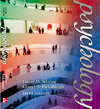Lester M. Sdorow,
Arcadia University
Cheryl A. Rickabaugh,
University of Redlands
| algorithm | A problem-solving rule or procedure that, when followed step by step, assures that a correct solution will be found.
|
 |
 |
 |
| artificial intelligence (AI) | The field that integrates computer science and cognitive psychology in studying information processing through the design of computer programs that appear to exhibit intelligence.
|
 |
 |
 |
| availability heuristic | In decision making, the tendency to estimate the probability of an event by how easily relevant instances of it come to mind.
|
 |
 |
 |
| cognitive neuroscience | The study of the neurological bases of cognitive processes.
|
 |
 |
 |
| cognitive psychology | The psychological viewpoint that favors the study of how the mind organizes perceptions, processes information, and interprets experiences.
|
 |
 |
 |
| concept | A category of objects, events, qualities, or relations that share certain features.
|
 |
 |
 |
| convergent thinking | The cognitive process that focuses on finding conventional solutions to problems.
|
 |
 |
 |
| creativity | A form of problem solving that generates novel, socially valued solutions to problems.
|
 |
 |
 |
| critical period | A period in childhood when experience with language produces optimal language acquisition.
|
 |
 |
 |
| decision making | A form of problem solving in which one tries to make the best choice from among alternative judgments or courses of action.
|
 |
 |
 |
| deep structure | The underlying meaning of a statement.
|
 |
 |
 |
| displacement | The characteristic of language marked by the ability to refer to objects and events that are not present.
|
 |
 |
 |
| divergent thinking | The cognitive process by which an individual freely considers a variety of potential solutions to artistic, literary, scientific, or practical problems.
|
 |
 |
 |
| framing effects | In decision making, biases introduced into the decision-making process by presenting an issue or situation in a certain manner.
|
 |
 |
 |
| functional fixedness | The inability to realize that a problem can be solved by using a familiar object in an unusual way.
|
 |
 |
 |
| generativity | The characteristic of language marked by the ability to combine words in novel, meaningful ways.
|
 |
 |
 |
| grammar | The set of rules that governs the proper use and combination of language symbols.
|
 |
 |
 |
| heuristic | A general principle that guides problem solving, though it does not guarantee a correct solution.
|
 |
 |
 |
| holophrastic speech | The use of single words to represent whole phrases or sentences.
|
 |
 |
 |
| insight | An approach to problem solving that depends on mental manipulation of information rather than overt trial and error, and produces sudden solutions to problems.
|
 |
 |
 |
| language | A formal system of communication involving symbols--whether spoken, written, or gestured--and rules for combining them.
|
 |
 |
 |
| linguistic relativity hypothesis | Whorf's hypothesis that one's perception of the world is molded by one's language.
|
 |
 |
 |
| logical concept | A concept formed by identifying the specific features possessed by all things that the concept applies to.
|
 |
 |
 |
| mental set | A tendency to use a particular problem-solving strategy that has succeeded in the past but that may interfere with solving a problem requiring a new strategy.
|
 |
 |
 |
| morphemes | The smallest meaningful units of language.
|
 |
 |
 |
| natural concept | A concept, typically formed through everyday experience, whose members possess some, but not all, of a common set of features.
|
 |
 |
 |
| overextension | The tendency to apply a word to more objects or actions than it actually represents.
|
 |
 |
 |
| overregularization | The application of a grammatical rule without making necessary exceptions to it.
|
 |
 |
 |
| phoneme | The smallest unit of sound in a language.
|
 |
 |
 |
| phonology | The study of the sounds that compose languages.
|
 |
 |
 |
| pragmatics | The relationship between language and its social context.
|
 |
 |
 |
| problem solving | The thought process by which an individual overcomes obstacles to reach a goal.
|
 |
 |
 |
| prototype | The best representative of a concept.
|
 |
 |
 |
| representativeness heuristic | In decision making, the assumption that a small sample is representative of its population.
|
 |
 |
 |
| semanticity | The characteristic of language marked by the use of symbols to convey thoughts in a meaningful way.
|
 |
 |
 |
| semantics | The study of how language conveys meaning.
|
 |
 |
 |
| surface structure | The word arrangements used to express thoughts.
|
 |
 |
 |
| syntax | The rules that govern the acceptable arrangement of words in phrases and sentences.
|
 |
 |
 |
| telegraphic speech | Speech marked by reliance on nouns and verbs, while omitting other parts of speech, including articles and prepositions.
|
 |
 |
 |
| thinking | The mental manipulation of words and images, as in concept formation, problem solving, and decision making.
|
 |
 |
 |
| transformational grammar | The rules by which languages generate surface structures from deep structures, and deep structures from surface structures.
|
 |
 |
 |
| trial and error | An approach to problem solving in which the individual tries one possible solution after another until one works.
|
 |
 |
 |
| underextension | The tendency to apply a word to fewer objects or actions than it actually represents.
|



 2002 McGraw-Hill Higher Education
2002 McGraw-Hill Higher Education

 2002 McGraw-Hill Higher Education
2002 McGraw-Hill Higher Education